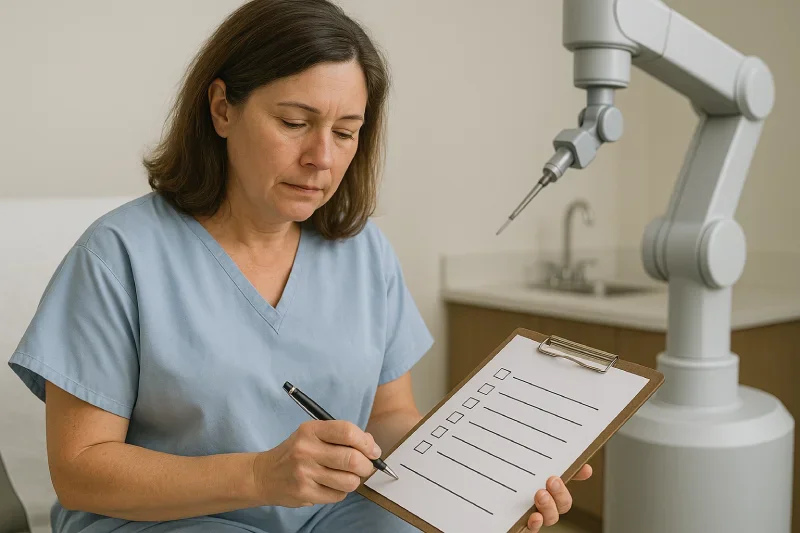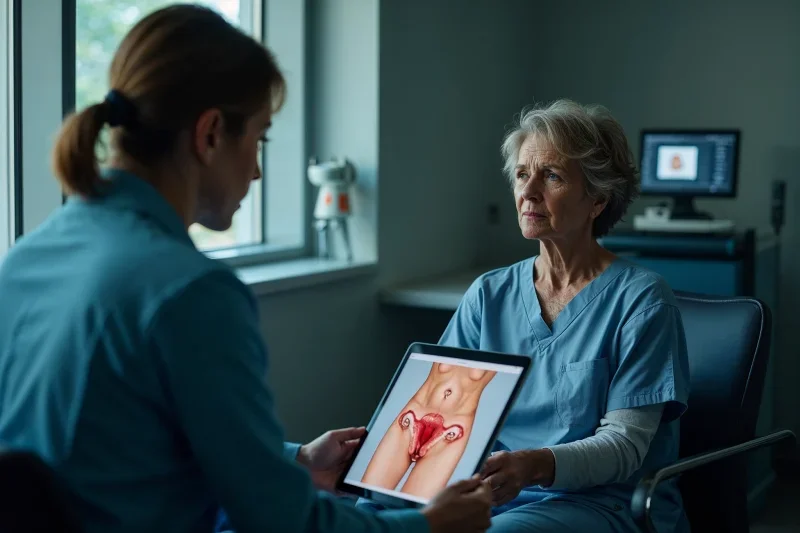Why is My Stomach Bigger After a Robotic Hysterectomy in Burleson,
Categories:
By: Ethan Cole
A noticeably larger abdomen after a robotic hysterectomy often surprises many patients in the Dallas-Fort Worth area, yet the cause is usually a predictable mix of post-surgical swelling, residual gas, and temporary constipation rather than a serious complication such as stomach cancer.
Although this minimally invasive surgery uses small incisions and advanced robotic arms, your abdominal area still goes through significant internal manipulation, CO₂ insufflation, and anesthesia—all of which can leave your belly feeling tight and distended in the early recovery process.
Below we explore why your stomach may appear rounder, how long the discomfort can last in North Texas, and evidence-based treatment options that promote a smoother recovery.
Key Takeaways
Post-operative abdominal swelling, trapped gas, and slowed bowel motility are the chief reasons your stomach looks bigger after a robotic surgical procedure.
Most swelling diminishes within three to four weeks; full resolution of abdominal bloating may take up to three months, especially after a full hysterectomy that includes removal of the uterus, ovaries and fallopian tubes.
Walking, deep breathing, adequate hydration, fiber-rich meals, and over-the-counter gas relief can shorten recovery time and reduce severe pain.
Red-flag symptoms—sharp worsening pain, fever, foul discharge, or rapidly expanding girth—require the opinion of a surgeon or your primary healthcare provider to rule out potential complications such as infection or hernia.
Minimally invasive robotic surgery typically results in fewer complications and a shorter hospital stay than traditional open surgery, but diligent self-care is still critical to achieve successful surgery outcomes.
Understanding Post-Operative Abdominal Changes
Even though the da Vinci robotic system allows surgeons to perform the surgery through a small incision—often less than an inch—the surrounding tissue reacts to the procedure much like it would after any abdominal surgery. CO₂ is pumped into the cavity to lift the abdominal wall away from the reproductive organs, giving the robotic arms room to work. While the technique is far gentler than open surgery or even older laparoscopic methods, your body interprets the event as trauma and launches an inflammatory response.
Normal Healing Response and Swelling
Inflammation is your body’s first responder. Blood vessels dilate, immune cells rush to the site, and extra fluid accumulates in the abdominal area. This edema peaks around day two or three, then drains slowly through the lymphatic system. An abdominal binder or cool gel wrap worn several times per day for fifteen minutes can reduce surface swelling without interfering with deeper healing.
Gas Retention From CO₂ Insufflation
Because carbon dioxide creates space for robotic procedures, a small amount lingers between bowel loops or beneath the diaphragm. The trapped air can migrate upward, resulting in shoulder-tip discomfort the day after surgery. Gentle walking, side-lying stretches, and deep breathing exercises encourage the body to absorb and expel this gas.
Constipation and Reduced Motility
Anesthesia, narcotic pain medication, and limited activity conspire to slow the intestines. Stool and air stagnate, pressure builds, and your abdomen feels rock-hard. Adding fiber supplements, drinking warm prune juice, and—if cleared by your healthcare provider—using a stool softener are often enough to relieve constipation within 48 hours.
|
Cause of Belly Enlargement |
Typical Onset |
Expected Duration |
Helpful Strategy |
Call the Doctor If… |
|
Surgical edema |
Day 1 |
1–3 weeks |
Cool compresses, light walking |
Swelling worsens after Day 4 |
|
CO₂ gas |
Hours 0–48 |
2–7 days |
Deep breathing, peppermint tea |
Persistent chest or shoulder pain |
|
Constipation |
Day 2 |
Until first BM |
Fiber, hydration, stool softener |
No BM by Day 4 |
|
Fluid retention |
Day 3 |
1–2 weeks |
Low-sodium diet |
Sudden weight gain >4 lbs |
|
Infection/hernia |
Day 4+ |
Variable |
— |
Fever, redness, firm bulge |
Factors That Influence the Severity of Bloating
Surgical Technique and CO₂ Volume
Different surgeons use slightly different CO₂ pressures during robotic surgery. Higher pressures might prolong gas absorption, so discuss the details of your procedure with your Burleson surgeon during preparation for surgery.
Individual Healing and Inflammation
Genetics, underlying medical treatment such as diabetes management, and prior abdominal surgeries—including bariatric surgery or hernia surgeries—affect your inflammatory response. Controlling blood sugar and following prescribed anti-inflammatory schedules help moderate swelling.
Lifestyle Choices: Diet, Hydration, Activity
A high-salt diet draws fluid into tissues. Skimping on water thickens intestinal contents, while staying sedentary slows lymphatic drainage. Aim for 8–10 cups of water, at least 1,500 steps on the day after surgery, and gradually increase activity to promote a smoother recovery.
How is the Uterus Removed in Robotic Hysterectomy?
During robotic hysterectomy, the uterus is detached internally using tiny robotic instruments controlled by the surgeon. Once separated, it can be removed through small abdominal incisions or via the vagina, depending on the surgical plan. In Burleson, most procedures use a minimally invasive approach with 4–5 tiny incisions less than an inch long. This method avoids the large scar and extended recovery associated with traditional open surgery.
Robotic Hysterectomy Incisions
A typical robotic hysterectomy involves 4–5 small incisions placed in the lower abdomen, each about 0.5–1 inch in length. These ports allow the robotic arms and camera to enter the abdominal cavity. The incisions are usually closed with dissolvable sutures and heal within 1–2 weeks. Scarring is minimal and often fades to nearly invisible lines over time, especially when incisions are placed low along the bikini line.
Robotic Hysterectomy Recovery
Most women are able to leave the hospital within 24 hours and return to light activities within 1–2 weeks. Full recovery typically takes 4–6 weeks, though this depends on overall health, extent of the surgery, and whether the ovaries or fallopian tubes were removed at the same time. Walking, hydration, and avoiding heavy lifting are critical for reducing swelling and preventing complications.
How Long Should the Swelling Last for Burleson Patients?
Week 1: Abdomen feels tight, bloated, and tender; gas pains peak around 48 hours.
Weeks 2–4: Swelling steadily decreases; many patients still notice nightly puffiness.
Week 6: Most women have resumed normal clothing sizes, although minor evening distension may linger.
Month 3: Any residual bloating usually resolves unless a hernia or other serious complication is present.
If distension worsens or fails to improve, contact your surgeon, especially if you develop severe pain, fever, or drainage from the incision site.
Practical Tips to Reduce Abdominal Swelling
Gentle Movement and Deep Breathing
Take five-minute walks every two hours. Use diaphragmatic breathing: inhale for four counts, hold for two, exhale for six. This simple exercise mobilizes the diaphragm, massages the intestines, and mitigates CO₂ retention.Smart Nutrition Choices
Start with the BRAT diet—bananas, rice, applesauce, toast—then progress to oats, steamed vegetables, and lentil soup.
Avoid carbonated drinks and artificial sweeteners, which can swell the stomach and intestinal tract.Hydration and Electrolytes
Warm lemon water jump-starts digestion. Sugar-free electrolyte packets replace minerals lost during surgery and recovery.Over-the-Counter Aids
Simethicone breaks up gas bubbles.
Polyethylene glycol (MiraLAX) softens stool without cramping.
Avoid stimulant laxatives unless specifically advised by your healthcare provider.Use of an Abdominal Binder
Wearing a supportive binder during waking hours for the first two weeks can decrease abdominal pressure and support the small incision sites.
Monitoring Your Recovery With Your Burleson Gynecologic Team
Regular follow-ups allow your surgeon to confirm that healing is on track and that there is no risk of infection or other potential complications.
What to Bring Up at Appointments
Morning vs. evening waist measurements
Pain medication usage and effectiveness
Bowel habits and dietary tolerance
Any bulges near incision sites that persist overnight
Red Flags Needing Immediate Attention
Sudden asymmetric swelling, indicating a possible incisional hernia
High fever or foul-smelling discharge, which may point to infection
Severe or increasing abdominal pain unrelieved by rest or medication
Keeping a Symptom Journal
Logging daily fluid intake, step count, bowel movements, and pain levels helps your provider tailor treatment options precisely to your needs.
Looking Ahead: Long-Term Outlook
Robotic technology, when paired with an experienced surgeon close to the patient in North Texas, generally leads to fewer complications, shorter hospital stays, and reduced risk of infection compared with traditional open surgery.
Whether you chose laparoscopic or robotic surgical removal of reproductive organs due to uterine fibroids, abnormal bleeding, or as preventive treatment for stomach cancer syndromes, your long-term quality of life often improves dramatically after you get a hysterectomy.
With realistic expectations and diligent self-care, most women regain full strength within six to eight weeks and resume normal exercise by three months.
Conclusion
Post-surgical edema, retained CO₂ gas, and constipation are the main reasons your stomach seems bigger after undergoing a hysterectomy via minimally invasive robotic procedures. Fortunately, these issues usually improve within weeks and rarely indicate a serious complication. Follow the strategies discussed—gentle movement, deep breathing, smart nutrition, and regular follow-ups—to foster a faster, smoother recovery.
If in doubt, seek the opinion of a surgeon promptly. With time and proper care, your abdomen will return to form, letting you enjoy life in the Dallas-Fort Worth area without the symptoms that prompted surgery in the first place.
Concerned about swelling? Schedule your recovery checkup today.
Call (817) 568-8731Categories:
Frequently Asked Questions
-
Most women with desk jobs resume work in 10–14 days, provided they can take brief walks and avoid lifting heavier than ten pounds. Physically demanding jobs may require four to six weeks off. Always confirm with your healthcare provider because the exact recovery time depends on the type of surgery and individual healing.
-
Yes. A partial hysterectomy typically removes just the uterus, so internal disruption is less extensive. That often means less inflammation and quicker resolution of bloating. However, factors like CO₂ volume, pain medication, and your personal healing response still influence total recovery time.
-
Absolutely. Both laparoscopic and robotic systems use CO₂ to inflate the abdominal cavity. The shoulder-tip pain many patients feel comes from this gas, not the robotic arms themselves. Walking, heat packs, and simethicone help regardless of surgical platform.
-
During robotic hysterectomy, the uterus is detached with robotic instruments and removed either through small abdominal incisions or vaginally. This minimally invasive approach avoids large scars and typically shortens recovery compared to traditional open procedures.
-
Opioid analgesics slow bowel motility, making constipation more likely. Ask your provider about alternating with non-narcotic options such as acetaminophen or NSAIDs—assuming no contraindications—to relieve severe pain yet minimize intestinal slowdown.
-
While adhesions can form after any abdominal surgery, minimally invasive surgery carries a lower risk than traditional open techniques. Staying active and following post-op guidelines further reduces the likelihood of problematic scar tissue.
-
Most robotic hysterectomies require 4–5 small abdominal incisions, each about half an inch long. These allow insertion of the robotic arms and camera. Incisions heal within weeks and usually leave only faint scars along the lower abdomen.
-
Mild pulling or tingling up to six weeks after surgery is usually normal scar tissue maturing beneath a small incision. Sharp, persistent, or enlarging pain, however, warrants evaluation to rule out a hernia or infection.
-
Yes. Many hospitals and surgical practices provide educational videos showing how robotic hysterectomy works. These resources help patients understand the steps, instruments, and recovery expectations. Dr. Neef’s office can direct Burleson patients to trusted video examples during consultation.
-
Removing the fallopian tubes can lower the risk of ovarian and certain peritoneal cancers. Your healthcare provider will explain whether salpingectomy during hysterectomy is advisable based on family history, genetic testing, and overall treatment goals.












